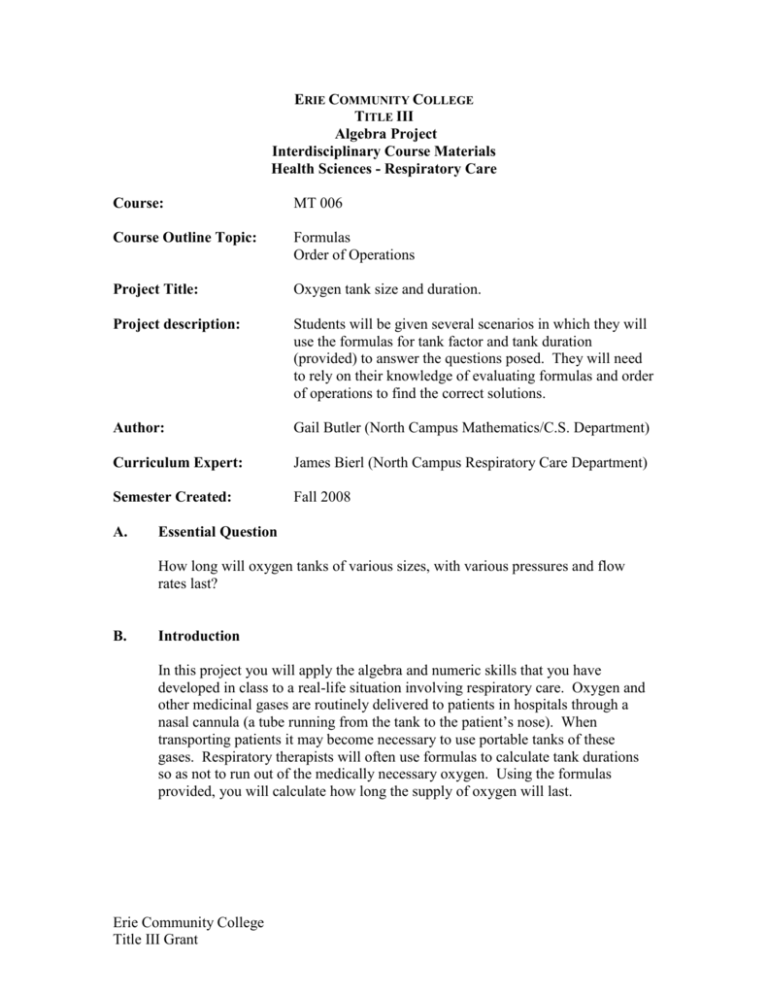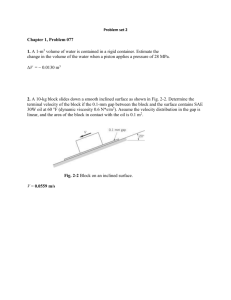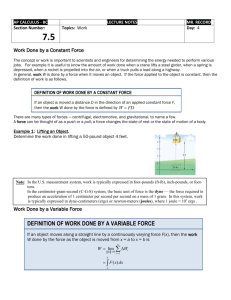Oxygen Tank Size & Duration: Algebra in Respiratory Care
advertisement

ERIE COMMUNITY COLLEGE TITLE III Algebra Project Interdisciplinary Course Materials Health Sciences - Respiratory Care Course: MT 006 Course Outline Topic: Formulas Order of Operations Project Title: Oxygen tank size and duration. Project description: Students will be given several scenarios in which they will use the formulas for tank factor and tank duration (provided) to answer the questions posed. They will need to rely on their knowledge of evaluating formulas and order of operations to find the correct solutions. Author: Gail Butler (North Campus Mathematics/C.S. Department) Curriculum Expert: James Bierl (North Campus Respiratory Care Department) Semester Created: Fall 2008 A. Essential Question How long will oxygen tanks of various sizes, with various pressures and flow rates last? B. Introduction In this project you will apply the algebra and numeric skills that you have developed in class to a real-life situation involving respiratory care. Oxygen and other medicinal gases are routinely delivered to patients in hospitals through a nasal cannula (a tube running from the tank to the patient’s nose). When transporting patients it may become necessary to use portable tanks of these gases. Respiratory therapists will often use formulas to calculate tank durations so as not to run out of the medically necessary oxygen. Using the formulas provided, you will calculate how long the supply of oxygen will last. Erie Community College Title III Grant C. Basic Directions All work is to be shown in an organized fashion on separate paper. Your work should be clearly labeled. In addition to correct answers, neatness and legibility are required for full credit. You may use a calculator for the computations. If necessary, round intermediate decimal values (numbers that will be used again to find the final answer) to the nearest hundredth. Round final answers as indicated in each question. You are to complete this project on your own. It will count toward your final grade as indicated in your instructor’s syllabus. D. Things to Learn Before Starting the Project 1. 2. 3. 4. 5. Know how to evaluate a formula when given values for certain variables. Know how to apply order of operations when performing computations. Know how to convert hours into hours and minutes. Know how to round decimal values Formulas: A. 1 cubic foot ( ft 3 ) = 28.3 Liters (L.) B. C. (Tank size is measured in cubic feet) Tank Duration (in minutes) = (Pressure in tank is measured in PSI: pounds per square inch) E. The Project Assignment Problem #1 A small cylinder of oxygen (22 ft3) is being used to transport a patient to x-ray. The tank is full (2200 PSI) and its flow to the nasal cannula is 2 L/M. How long will this tank last? (Note: you will first need to find the tank factor, then use it to calculate the tank duration). Express your answer in minutes. Then, convert your answer to hours and minutes. Problem #2 Erie Community College Title III Grant A large cylinder (244 ft3) is being used to deliver oxygen in the Pulmonary Function Laboratory. The cylinder has 1850 PSI and is running an oxygen mask at 8 L/M. How long will the tank last? Express your answer in minutes. Then, convert your answer to hours and minutes. Problem #3 A respiratory therapist is setting up 1 full oxygen cylinder (2200 PSI) and 1 half-full oxygen cylinder in an outpatient facility. Each cylinder contains 187 ft3 when full. Oxygen will be delivered to a patient at a flow of 5 L/M continuously. How long will the cylinders last? Express your answer in hours and minutes. Problem #4 A patient on a 1 liter nasal cannula is being air transported to Cleveland from Buffalo. They are traveling with one full (2200 PSI) cylinder (size 22 ft3). The transport therapist expects the transport to last one hour. Do they have enough oxygen for the transport? Problem #5 A transport respiratory therapist is traveling to Niagara Falls Memorial Medical Center to pick up a premature baby who was just delivered in their Emergency Room. The therapist calculates that they will need a maximum of 15 L/M of oxygen to safely transport the infant back to Children’s Hospital. They expect the transport to last 2 hours. How many small tanks (size 22 ft3) will be needed for the transport? F. Student Resources (websites, books, technology, etc.) Textbook http://www.monroecc.edu/depts/pstc/backup/paraoxca.htm Eagan’s Fundamentals of Respiratory Care – 9th edition. G. Faculty Resources (teacher notes, websites, books, technology, etc.) Eagan’s Fundamentals of Respiratory Care – 9th edition. Erie Community College Title III Grant H. Suggested Grading Rubric Problem #1: 8 points Problem #2: 8 points Problem #3: 13 points Problem #4: 8 points Problem #5: 8 points Neatness and Legibility: 5 points Erie Community College Title III Grant Project Answer Key: 1. (Tank size is measured in cubic feet) Tank Factor = (22)( 28.3) 622.6 0.28 2200 2200 Tank Duration (in minutes) = Tank Duration = (0.28)( 2200) 308 minutes = 5 hours 8 minutes 2 2. (Tank size is measured in cubic feet) Tank Factor = (244)( 28.3) 6905.2 3.14 2200 2200 Tank Duration (in minutes) = Tank duration = (3.14)(1850) 726.13 minutes = 12 hours 6.13 minutes 8 3. (Tank size is measured in cubic feet) Tank Factor = (187)( 28.3) 2.41 2200 Tank Duration (in minutes) = Tank 1 duration = (2.41)( 2200) 1060.4 minutes 5 Erie Community College Title III Grant Tank 2 duration = (2.41)(1100) 530.6 minutes 5 Sum of tank durations = 1590.6 minutes = 26 hours 31 minutes 4. (Tank size is measured in cubic feet) Tank Factor = (22)( 28.3) 0.28 2200 Tank Duration (in minutes) = Tank duration = (0.28)( 2200) 616 minutes = 10 hours 16 minutes; YES 1 5. (Tank size is measured in cubic feet) Tank Factor = (22)( 28.3) 0.28 2200 Tank Duration (in minutes) = Tank duration = (0.28)( 2200) 41 minutes 15 2 hours = 120 minutes Erie Community College Title III Grant 120/41 = 2.93, therefore 3 tanks are needed.








